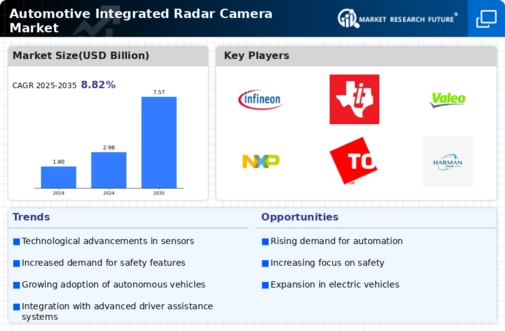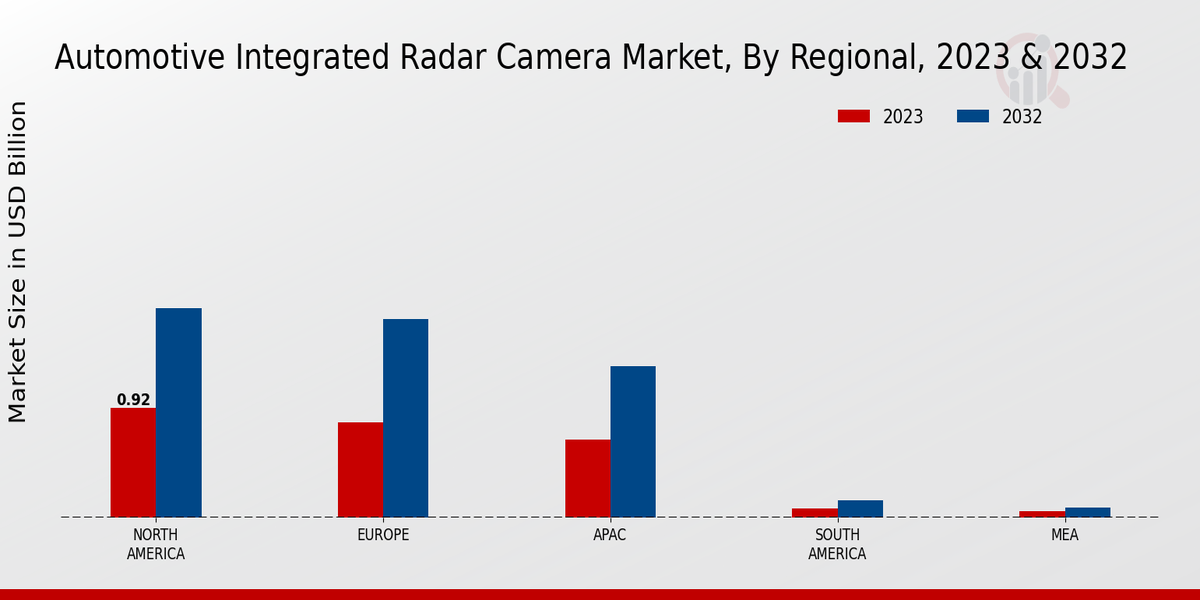Regulatory Support
Government regulations aimed at enhancing vehicle safety are significantly driving the Global Automotive Integrated Radar Camera Market Industry. Many countries are implementing stricter safety standards that necessitate the inclusion of advanced safety features in new vehicles. For example, the European Union has mandated that all new cars must be equipped with certain ADAS features by 2022. This regulatory push encourages manufacturers to integrate radar camera systems into their vehicles, thereby increasing market demand. As safety regulations evolve, the market is likely to see a sustained increase in adoption rates, contributing to its growth trajectory and aligning with the projected market value of 7.57 USD Billion by 2035.
Market Growth Projections
The Global Automotive Integrated Radar Camera Market Industry is poised for substantial growth, with projections indicating an increase from 2.98 USD Billion in 2024 to 7.57 USD Billion by 2035. This growth trajectory suggests a compound annual growth rate of 8.85% from 2025 to 2035. Such figures reflect the increasing integration of advanced safety features in vehicles, driven by consumer demand and regulatory requirements. The market's expansion is further supported by technological advancements in radar and camera systems, which enhance vehicle safety and automation. As the automotive industry evolves, the demand for integrated radar cameras is likely to rise, aligning with these optimistic growth projections.
Technological Advancements
The Global Automotive Integrated Radar Camera Market Industry is experiencing rapid technological advancements, particularly in sensor fusion and artificial intelligence. These innovations enhance vehicle safety and automation, leading to increased adoption of integrated radar cameras in vehicles. For instance, advanced driver-assistance systems (ADAS) leverage these technologies to improve functionalities such as adaptive cruise control and lane-keeping assistance. The integration of radar and camera systems provides a more comprehensive understanding of the vehicle's surroundings, which is crucial for the development of autonomous vehicles. As a result, the market is projected to grow from 2.98 USD Billion in 2024 to 7.57 USD Billion by 2035, reflecting a compound annual growth rate of 8.85% from 2025 to 2035.
Rise of Autonomous Vehicles
The rise of autonomous vehicles is a transformative factor for the Global Automotive Integrated Radar Camera Market Industry. As automakers invest heavily in developing self-driving technologies, the demand for integrated radar cameras is surging. These cameras play a crucial role in enabling vehicles to perceive their environment accurately, which is essential for safe navigation. Companies like Waymo and Tesla are at the forefront of this trend, utilizing advanced radar and camera systems to enhance their autonomous driving capabilities. This shift towards automation is expected to propel the market's growth, with an anticipated increase in value from 2.98 USD Billion in 2024 to 7.57 USD Billion by 2035.
Consumer Demand for Safety Features
There is a growing consumer demand for enhanced safety features in vehicles, which is a key driver for the Global Automotive Integrated Radar Camera Market Industry. Consumers are increasingly aware of the benefits of advanced safety technologies, such as collision avoidance and pedestrian detection, which are facilitated by integrated radar cameras. This heightened awareness is prompting manufacturers to prioritize the development and integration of these systems in their vehicles. As a result, the market is expected to expand significantly, with projections indicating a rise from 2.98 USD Billion in 2024 to 7.57 USD Billion by 2035, driven by consumer preferences for safer driving experiences.
Market Penetration of Electric Vehicles
The increasing penetration of electric vehicles (EVs) is positively influencing the Global Automotive Integrated Radar Camera Market Industry. As EV manufacturers strive to differentiate their products, many are incorporating advanced safety and driver-assistance features that rely on integrated radar cameras. This trend is particularly evident in the growing number of EV models that offer enhanced safety technologies as standard features. The expansion of the EV market is expected to drive demand for integrated radar systems, contributing to the overall market growth. With projections indicating a market value of 7.57 USD Billion by 2035, the synergy between EV adoption and radar camera integration appears promising.























